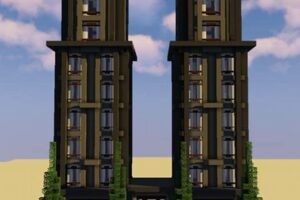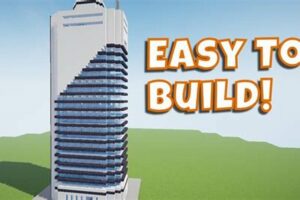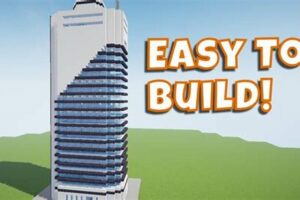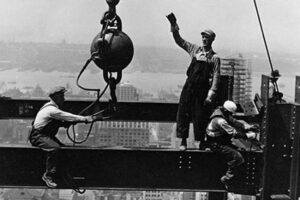Building a paper skyscraper is an engaging and educational activity that can teach you about engineering, architecture, and design. It’s also a great way to exercise your creativity and have some fun.
The first step is to gather your materials. You will need:
- Paper
- Scissors
- Tape
- Ruler or measuring tape
- Pencil
Once you have your materials, you can start building your skyscraper. Here are the steps:
- Decide on the size and shape of your skyscraper. You can make it as tall or wide as you want.
- Cut out a rectangle of paper for the base of your skyscraper. The size of the rectangle will depend on the size of your skyscraper.
- Fold the rectangle in half lengthwise. This will create the two sides of your skyscraper.
- Tape the two sides of your skyscraper together along the edges.
- Cut out a rectangle of paper for the roof of your skyscraper. The size of the rectangle will depend on the size of your skyscraper.
- Fold the rectangle in half lengthwise. This will create the two sides of your roof.
- Tape the two sides of your roof together along the edges.
- Tape the roof to the top of your skyscraper.
- Decorate your skyscraper however you like. You can use markers, crayons, paint, or anything else you can think of.
1. Base
The base of your paper skyscraper is the most important part of the structure. It is what will keep your skyscraper standing upright and prevent it from collapsing. A wide and sturdy base will distribute the weight of the skyscraper evenly and prevent it from toppling over.
There are a few things to keep in mind when building the base of your skyscraper:
- The size of the base should be proportional to the size of the skyscraper. A small base will not be able to support a large skyscraper, and the skyscraper will likely collapse.
- The base should be made of thick, sturdy paper. Thin paper will not be able to support the weight of the skyscraper, and the skyscraper will likely collapse.
- The base should be reinforced with tape or glue. This will help to keep the base together and prevent it from coming apart.
Once you have built a strong and sturdy base, you can start to build the rest of your skyscraper. However, if the base is not strong enough, the entire skyscraper will be at risk of collapsing.
Here is an example of how the base of a paper skyscraper can affect its stability:
If you build a paper skyscraper with a small base, the skyscraper will be more likely to topple over. This is because the small base will not be able to distribute the weight of the skyscraper evenly. As a result, the skyscraper will be more likely to collapse.
However, if you build a paper skyscraper with a wide and sturdy base, the skyscraper will be much more stable. This is because the wide and sturdy base will be able to distribute the weight of the skyscraper evenly. As a result, the skyscraper will be less likely to collapse.
Conclusion:
The base of your paper skyscraper is the most important part of the structure. It is what will keep your skyscraper standing upright and prevent it from collapsing. A wide and sturdy base will distribute the weight of the skyscraper evenly and prevent it from toppling over.
2. Height
In the context of “how to build a paper skyscraper”, the height of the skyscraper is a crucial factor that influences the overall design, construction process, and stability of the structure. The taller the skyscraper, the more challenging it becomes to maintain its structural integrity and ensure its resilience against external forces.
- Structural Stability:
As the height of the skyscraper increases, the weight distribution becomes more complex, and the forces acting upon the structure become more significant. This necessitates careful consideration of the materials used, the design of the framework, and the incorporation of additional support systems to prevent buckling or collapse. - Wind Resistance:
Taller skyscrapers are more susceptible to wind forces, which can cause swaying and instability. To mitigate these effects, architects and engineers employ various techniques such as setbacks (gradual reductions in the building’s width as it rises), aerodynamic shaping, and the use of wind dampers to dissipate energy and reduce oscillations. - Material Selection:
The choice of materials for a paper skyscraper becomes increasingly critical as the height increases. Thicker and more durable paper or cardboard is required to withstand the weight and maintain the structural integrity of the skyscraper. Experimentation with different materials and innovative construction techniques can lead to taller and more resilient paper skyscrapers. - Construction Complexity:
Building a taller paper skyscraper requires meticulous planning, precision in execution, and often specialized techniques. The process involves careful assembly, reinforcement, and the addition of supportive elements to ensure the stability of the structure throughout its height.
In summary, the height of a paper skyscraper poses unique challenges that require careful consideration of structural stability, wind resistance, material selection, and construction complexity. Overcoming these challenges requires creativity, experimentation, and a deep understanding of the principles of engineering and architecture.
3. Shape
When building a paper skyscraper, the shape is an important factor to consider. The shape of the skyscraper will affect its stability, strength, and overall appearance. There are many different shapes that you can choose from, so be creative and experiment with different designs.
- Rectangular Skyscrapers:
Rectangular skyscrapers are the most common type of skyscraper. They are simple to build and can be very stable. However, they can also be quite boring to look at. - Triangular Skyscrapers:
Triangular skyscrapers are another popular type of skyscraper. They are more difficult to build than rectangular skyscrapers, but they can be very striking. The triangular shape helps to distribute the weight of the skyscraper evenly, making it more stable. - Cylindrical Skyscrapers:
Cylindrical skyscrapers are less common than rectangular and triangular skyscrapers. They are more difficult to build, but they can be very aerodynamic. The cylindrical shape helps to reduce the amount of wind resistance that the skyscraper experiences. - Free-Form Skyscrapers:
Free-form skyscrapers are the most unique type of skyscraper. They can be any shape that you can imagine. Free-form skyscrapers are often very expensive to build, but they can also be very beautiful.
The shape of your paper skyscraper is up to you. Be creative and experiment with different designs. The possibilities are endless.
4. Materials
When building a paper skyscraper, the choice of materials is important. The type of paper you use will affect the durability, stability, and overall appearance of your skyscraper. Thicker paper is more durable and will be able to support the weight of your skyscraper better than thinner paper. This is especially important for taller skyscrapers.
There are many different types of paper that you can use to build your skyscraper. Some popular choices include:
- Cardstock: Cardstock is a thick, durable paper that is often used for making cards and other crafts. It is a good choice for building paper skyscrapers because it is strong and can support the weight of taller structures.
- Construction paper: Construction paper is a thick, colored paper that is often used for making posters and other art projects. It is a good choice for building paper skyscrapers because it is durable and comes in a variety of colors.
- Origami paper: Origami paper is a thin, strong paper that is often used for making origami (Japanese paper folding). It is a good choice for building paper skyscrapers because it is lightweight and can be folded into complex shapes.
The type of paper you choose will depend on the size and design of your skyscraper. If you are building a small skyscraper, you can use thinner paper. However, if you are building a taller skyscraper, you will need to use thicker paper to support the weight of the structure.
In addition to the type of paper, you will also need to consider the weight of the paper. Heavier paper will be more durable, but it will also be more difficult to work with. If you are new to building paper skyscrapers, it is best to start with lighter paper. Once you have some experience, you can experiment with heavier paper to create taller and more complex structures.
The choice of materials is an important part of building a paper skyscraper. By choosing the right type and weight of paper, you can create a skyscraper that is both durable and beautiful.
5. Tools
In the context of “how to build a paper skyscraper”, the tools required play a crucial role in shaping the construction process and determining the final outcome of the skyscraper. These tools serve as extensions of the builder’s skills, enabling them to manipulate and assemble the paper materials with precision and efficiency.
- Cutting: Scissors are an essential tool for cutting the paper into various shapes and sizes. Precise cuts are necessary to ensure that the pieces fit together seamlessly and maintain the structural integrity of the skyscraper.
- Adhesion: Tape is used to adhere the paper pieces together, creating a strong and stable structure. The type of tape chosen should be appropriate for the weight and thickness of the paper being used.
- Measurement and Alignment: A ruler is used for measuring and aligning the paper pieces, ensuring that the skyscraper is constructed with accuracy and precision. It helps in maintaining the desired proportions and angles throughout the building process.
- Additional Tools: In addition to scissors, tape, and a ruler, other tools may be useful depending on the complexity of the skyscraper design. These could include a pencil for sketching and marking, a compass for drawing circles, or a protractor for measuring angles.
The appropriate selection and skillful use of these tools are essential for successful skyscraper construction. They empower the builder to realize their design vision, overcome challenges, and ultimately create a paper skyscraper that is both structurally sound and aesthetically pleasing.
6. Patience
In the context of “how to build a paper skyscraper”, patience is a virtue that can lead to remarkable achievements. Building a paper skyscraper requires careful planning, precision, and a willingness to persevere through setbacks. Here are a few key aspects that highlight the connection between patience and the successful construction of a paper skyscraper:
- Attention to Detail: Patience allows for meticulous attention to detail, ensuring that each component of the skyscraper is crafted with precision. This includes precise cutting, careful folding, and meticulous assembly, all of which contribute to the overall stability and aesthetics of the structure.
- Problem-Solving: Patience fosters a problem-solving mindset, enabling the builder to overcome challenges that may arise during the construction process. Setbacks are inevitable, but with patience, the builder can analyze the situation, explore alternative solutions, and refine their approach to achieve the desired outcome.
- Learning from Mistakes: Patience creates a space for learning and growth. The first attempt at building a paper skyscraper may not be perfect, but with patience, the builder can identify areas for improvement, learn from their mistakes, and refine their techniques for future endeavors.
- Enjoyment of the Process: Patience allows the builder to savor the process of creating a paper skyscraper. It transforms the task from a rushed project to an enjoyable and fulfilling experience, where the builder can appreciate the intricacies of the design and the satisfaction of completing a challenging yet rewarding endeavor.
Embracing patience in the journey of building a paper skyscraper not only increases the likelihood of success but also enriches the overall experience. It cultivates a mindset of perseverance, creativity, and the pursuit of excellence, leading to the construction of paper skyscrapers that are both structurally sound and aesthetically pleasing.
7. Creativity
In the realm of “how to build a paper skyscraper”, creativity serves as a boundless catalyst, empowering builders to transcend the confines of conventional design and embark on a journey of limitless possibilities. This facet of skyscraper construction is multifaceted, encompassing various elements that contribute to the uniqueness and ingenuity of each structure.
- Unleashing Imagination: Creativity allows builders to break free from traditional blueprints and embrace their imagination. By envisioning unconventional designs, exploring novel shapes, and incorporating unexpected elements, they push the boundaries of what a paper skyscraper can be.
- Personalized Expression: Creativity provides a platform for builders to express their individuality and artistic vision. Each paper skyscraper becomes a reflection of the builder’s unique perspective, showcasing their creativity and personal style.
- Innovative Solutions: Faced with the challenges of gravity and structural stability, creativity empowers builders to devise innovative solutions. They experiment with different materials, construction techniques, and support systems to create skyscrapers that defy expectations.
- Aesthetic Appeal: Creativity extends beyond functionality, allowing builders to create paper skyscrapers that are not only structurally sound but also visually captivating. By incorporating intricate details, vibrant colors, and harmonious proportions, they transform these structures into works of art.
In conclusion, creativity is an indispensable aspect of “how to build a paper skyscraper”. It empowers builders with the freedom to explore, innovate, and express themselves. Through creativity, paper skyscrapers evolve from mere structures into testaments to the boundless possibilities of human imagination.
8. Stability
In the context of “how to build a paper skyscraper”, stability is a critical aspect that ensures the structural integrity and resilience of the skyscraper. Without proper attention to stability, the skyscraper may collapse under its weight or external forces, leading to a failed construction.
- Structural Reinforcement:
Stability is achieved by reinforcing the structure of the skyscraper. This involves strategically applying tape or glue to strengthen the joints and connections between the paper components. Proper reinforcement helps distribute the weight evenly and prevents the skyscraper from buckling or bending under pressure.
- Base Support:
The stability of a paper skyscraper heavily relies on the strength of its base. The base provides a solid foundation that supports the weight of the entire structure. By ensuring a wide and sturdy base, the skyscraper can better withstand external forces and maintain its upright position.
- Wind Resistance:
In real-life skyscrapers, wind resistance is a significant factor that can affect stability. While paper skyscrapers may not experience the same level of wind forces, it is still important to consider the potential impact of air currents on the structure. Strategic placement of supporting elements and aerodynamic shaping can help mitigate the effects of wind and enhance stability.
- Height Considerations:
The height of the paper skyscraper also influences its stability. Taller skyscrapers are more susceptible to swaying and buckling due to increased weight and wind forces. To maintain stability in taller structures, builders may need to employ additional support systems, such as internal or external buttresses.
In conclusion, ensuring stability is paramount in the construction of a paper skyscraper. By carefully reinforcing the structure, providing a sturdy base, considering wind resistance, and taking into account height considerations, builders can create paper skyscrapers that are resilient and capable of standing tall.
9. Decoration
The decoration of a paper skyscraper is not merely an aesthetic afterthought; it is an integral part of the construction process that can significantly enhance the stability, durability, and overall appearance of the structure.
Structural Reinforcement:
Decorative elements can serve as structural reinforcements, providing additional support to critical areas of the skyscraper. For instance, adding paper mch or cardboard panels to the base of the structure can enhance its stability and prevent buckling. Similarly, decorative flourishes such as arches or buttresses can strengthen the walls and prevent them from collapsing inward.
Environmental Protection:
Decorations can also protect the paper skyscraper from environmental factors. Applying a layer of paint or sealant to the exterior of the structure can create a waterproof barrier, safeguarding it from moisture damage anding its lifespan. Additionally, decorative elements such as awnings or overhangs can provide shade and protect the skyscraper from the sun’s harmful UV rays.
Creative Expression:
Beyond its practical benefits, decoration allows builders to express their creativity and individuality. By incorporating intricate designs, vibrant colors, and unique patterns, builders can transform their paper skyscrapers into works of art. Decoration becomes a medium through which they can showcase their imagination and personal style.
In conclusion, the decoration of a paper skyscraper is not merely an optional embellishment; it is an essential component that contributes to the structural integrity, durability, and aesthetic appeal of the structure. By understanding the connection between decoration and the overall construction process, builders can create paper skyscrapers that are not only visually stunning but also resilient and long-lasting.
Frequently Asked Questions about “How to Build a Paper Skyscraper”
Delving into the world of paper skyscraper construction, it is understandable to encounter queries and uncertainties. This FAQ section aims to address some of the commonly asked questions, providing informative answers to guide you through the process of building a sturdy and captivating paper skyscraper.
Question 1: What type of paper is best suited for building a paper skyscraper?
The choice of paper can significantly impact the stability and durability of your paper skyscraper. Opt for thicker and more robust paper such as cardstock or construction paper. These papers provide a sturdy base for your structure, allowing it to withstand the weight and stresses involved in building a tall skyscraper.
Question 2: How can I ensure that my paper skyscraper is stable and does not collapse?
Stability is crucial for a successful paper skyscraper. Reinforce the structure by using tape or glue to secure the joints and connections. A sturdy base is essential, so pay attention to the foundation of your skyscraper. Additionally, consider the height of your structure, as taller skyscrapers may require additional support systems to maintain stability.
Question 3: What techniques can I use to decorate my paper skyscraper?
Decoration not only enhances the aesthetics of your paper skyscraper but can also provide structural support. Use markers, crayons, or paint to add vibrant colors and patterns. Consider incorporating decorative elements like arches or buttresses to reinforce the walls and enhance the overall design.
Question 4: How do I make my paper skyscraper resistant to environmental factors?
Protecting your paper skyscraper from environmental elements is essential for its longevity. Apply a layer of paint or sealant to the exterior to create a waterproof barrier. Decorative elements like awnings or overhangs can provide shade and shelter from the sun and rain.
Question 5: What is the best way to learn the art of building paper skyscrapers?
Practice and experimentation are key to mastering the art of building paper skyscrapers. Start with simple designs and gradually progress to more complex structures. Refer to online resources, books, or tutorials for guidance and inspiration. The learning journey is part of the fun, so enjoy the process.
Question 6: Is it possible to build a paper skyscraper that is both tall and stable?
Absolutely! Achieving a balance between height and stability requires careful planning and execution. Use thicker paper for taller structures and incorporate support systems like internal buttresses or external bracing. Remember, stability should not compromise the height of your paper skyscraper. With creativity and engineering principles, you can construct an impressive and stable skyscraper.
In essence, building a paper skyscraper involves a harmonious blend of creativity, structural know-how, and attention to detail. Embrace the process, experiment with different techniques, and let your imagination soar. The result will be a captivating paper skyscraper that stands tall as a testament to your skill and ingenuity.
Proceed to the next section for further insights into the fascinating world of paper skyscraper construction.
Tips for Building a Sturdy and Impressive Paper Skyscraper
Embarking on the journey of constructing a paper skyscraper requires careful planning and execution. Here are a few essential tips to guide you towards a successful and stable structure:
Tip 1: Foundation and Stability
A solid foundation is paramount for ensuring the stability of your paper skyscraper. Utilize thicker paper or cardboard for the base to provide a sturdy support system. Reinforce the base with tape or glue to prevent buckling or collapse under the weight of the structure.Tip 2: Reinforcing the Structure
As the height of your skyscraper increases, consider incorporating internal support systems to maintain its structural integrity. Internal buttresses or cross-bracing can provide additional support, preventing the walls from bowing outward and ensuring the overall stability of the structure.Tip 3: Strategic Use of Tape
Tape plays a crucial role in binding the components of your paper skyscraper together. Opt for strong adhesive tape that can withstand the weight and stresses involved in the construction process. Apply tape liberally to all joints and connections, ensuring a secure and robust structure.Tip 4: Precision in Cutting and Folding
Precision is key when cutting and folding the paper components of your skyscraper. Utilize a sharp blade or scissors to ensure clean and accurate cuts. Precise folding techniques will result in a more stable and visually appealing structure.Tip 5: Experiment with Different Paper Types
Explore the use of various paper types to enhance the durability and aesthetics of your skyscraper. Consider incorporating origami paper for intricate details or glossy paper for a reflective and modern look. Experimenting with different paper types can add depth and character to your creation.Tip 6: Creative Use of Decorative Elements
While decoration can enhance the visual appeal of your paper skyscraper, it can also contribute to its structural integrity. Decorative elements like arches, columns, or buttresses can provide additional support to the structure, reinforcing the walls and enhancing stability.Tip 7: Patience and Attention to Detail
Building a paper skyscraper requires patience and meticulous attention to detail. Take your time during the construction process, ensuring that each component is securely attached and aligned correctly. Avoid rushing through the process, as it can compromise the stability and overall appearance of your skyscraper.
By following these tips, you will be well-equipped to embark on the exciting journey of building a paper skyscraper that stands tall, sturdy, and captivating.
Conclusion
The art of constructing a paper skyscraper is an engaging and educational endeavor that encompasses various aspects of engineering, architecture, and design. Through careful planning, precision in execution, and a touch of creativity, it is possible to create a paper skyscraper that stands tall, sturdy, and captivating.
This exploration of “how to build a paper skyscraper” highlighted the importance of a strong foundation, strategic use of tape, precision in cutting and folding, and the incorporation of support systems to ensure stability. By understanding the principles of structural integrity and experimenting with different paper types and decorative elements, builders can push the boundaries of paper skyscraper construction.
The journey of building a paper skyscraper not only teaches valuable skills but also cultivates patience, problem-solving abilities, and a keen eye for detail. As you embark on your own paper skyscraper project, remember that the process is as rewarding as the final product. Embrace the challenge, experiment with different techniques, and let your creativity soar. With dedication and a touch of ingenuity, you will be able to craft an impressive paper skyscraper that stands as a testament to your skill and imagination.







